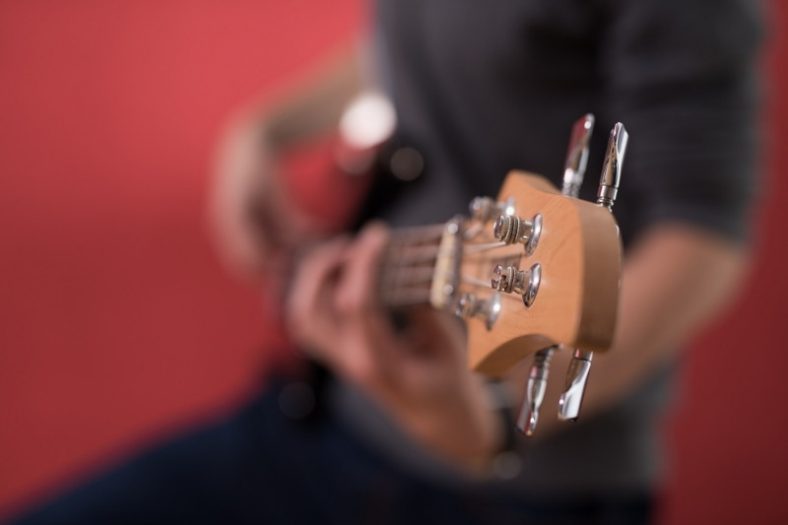How to Teach Yourself to Learn Bass Guitar (6 Tips)

There are ways to teach yourself how to play the bass. All it takes is making some time and dedication to be a self-taught bass player. This article has a few tips to help you on your journey.
Let’s say that you just bought a bass, but don’t want to spend the money or time taking private lessons and have someone standing over your head all the time. It can be stressful at times for sure, most people tend to bring the best out of themselves when they don’t feel shackled.
Creating a stress-free environment and having the will and dedication is all you need to learn the basics and start progressing in the world of bass playing. With all the knowledge on the internet today, it’s more than possible to be a self-taught bassist.
Here are a few tips for a good start!
Contents
1. Develop A Practice Routine
This is the first step to take when approaching this subject. No matter what instrument you play, it all comes down to practice. Developing a good practice routine early will help you better progress in the future.
Now, a simple thing like establishing a time in the day when you’d sit down and start practicing something basic is enough. Managing your time is an essential component of a good practice experience. If you don’t already own a bass guitar, then you should probably get one just so you can take the first step.
You don’t have to immediately engage in music theory and all that stuff. You simply need to feel at ease with your bass guitar and get as comfortable as possible before you start learning. Take some time to feel the strings, and the finger pressure you need to get a clear tone out. Basically, you need to loosen your fingers up for it to feel natural.
2. Hand Coordination
Before starting to play or learning any songs, you need to focus on building up your hand coordination. More simply put, to get used to one hand playing the strings and the other one holding the notes.
Now, while this may seem simple, it’s actually not, as you would need to learn how to properly mute other strings while playing single tones and not have any other notes pop up unexpectedly. This is a very basic thing, but it’s something that you should know. It’s better to focus on this in the beginning, than have it be a problem later on in your musical experience.
Let’s say, for example, if you’re right-handed, then your right hand will be in charge of the strings. This is where you will need to learn where to place your thumb for your hand to rest in order for your other fingers to play the strings successfully. Your left hand is in charge of holding down the notes.
As I said, it’s really important to know how to mute all other unnecessary strings for a particular note, so they don’t get in the way and you can get a clear sound out. You can start by practicing three or four notes in a certain manner to get the basic feel of playing.
3. Start With Scales
Learning how to play scales is the most important fundamental you will need to learn. Knowing how to play scales will be essential in everything that follows in your bass playing experience. It will help you play better, feel more at ease, and build a strong foundation for future practice and playing.
I would suggest starting out with learning a major and a minor scale and going as slow as possible in the beginning. Keep in mind that if you can play it slow, then you can play it fast, believe me. Focus on getting the right notes and getting a clear sound. Then gradually start implementing a faster tempo and so on.
Before you know it, you’ll be playing a scale with ease. By the time you learn your first scale, your fingers would have already adjusted to the pressure needed to pin down the strings. At first, your fingers will definitely hurt, but you’ll get used to it in time, as they’ll become more durable and eventually get to a level where your fingers are strong enough and don’t hurt anymore.
4. Practice With A Metronome
When you accumulate some knowledge on playing bass, it’s a good step forward to start practicing with a metronome. A metronome will help you develop a more natural rhythm to playing, as well as keep you in check while you’re still getting there.
When you start implementing a metronome in your practice, you will immediately see if you have a natural rhythm to yourself. If following the metronome is easy for you then you have a good rhythm foundation, though it can be hard for some people, practicing will still get you to that level.
It’s very important to keep a solid rhythm when playing because it can be overlooked in the beginning, but it is actually an important fundamental to keep in mind.
5. Learn Your First Song
Now that you’ve gone through the technical part, it’s time to learn your first song. It’s best to start with something with a basic bass in it. You can go with “Knocking On Heaven’s Door” by Guns N’ Roses, which is always a go-to for all bass beginners. It has a really simple bass and it’s a good way to see if you’re developing correctly if you can keep a good rhythm and get over that first hurdle.
Over time you can give yourself more of a challenge in order to help you progress. Picking a harder song might help you better improve in a lot less time. Setting a challenge that is further out of reach will just motivate you to practice more and keep getting better.
6. Keep Practicing
The most important thing to keep in mind is to keep practicing. With all the knowledge that’s on the internet today, It’s really easy to progress if you have a regular practice routine. You can eventually move forward and learn music theory and reading tabs just to get to that next step.
Where do you go from here, all depends on you. Keep practicing and keep learning new stuff and you’ll become better in no time. I was a self-taught bass player myself and these are the tips that I was given when I was starting out. All I can say is that it worked for me. Here I am nine years later, still playing and still getting better.
Summary
It’s more than possible to teach yourself how to play bass guitar and these tips will assist you in doing so. First you will need to develop a practice routine, which means setting aside time in the day where you can sit down and practice. You’ll need to learn how to feel at ease with your bass, to get used to the neck and strings.
The next step is hand coordination. One hand has to get used to playing the strings while the other one holds the notes. Keep in mind that you have to mute certain strings in order to avoid unnecessary notes popping up. You start with practicing and learning scales which will help you build a strong foundation for your bass playing. The next step is to start implementing a metronome in your practicing, which will help you develop a natural rhythm while playing.
Then you can learn your first song. You can start with something basic and then set yourself up with some challenges along the way to help you get better faster. The one thing you have to keep in mind is practice makes perfect. There’s tons of knowledge on the internet today that will help you progress further. All it takes is dedication and time.





